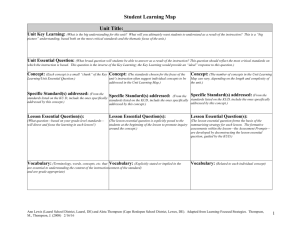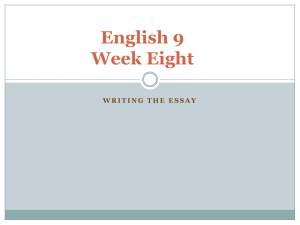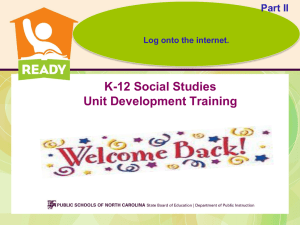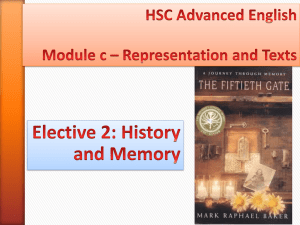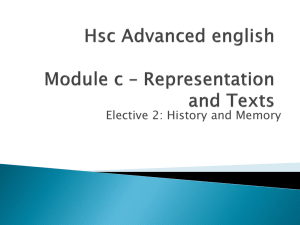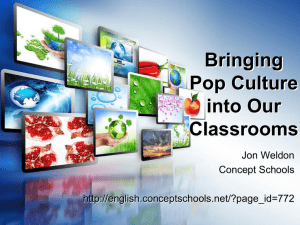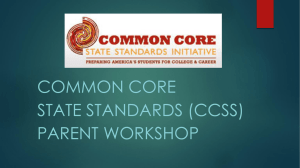KUD Organizers - DSCYFEducation Wiki
advertisement
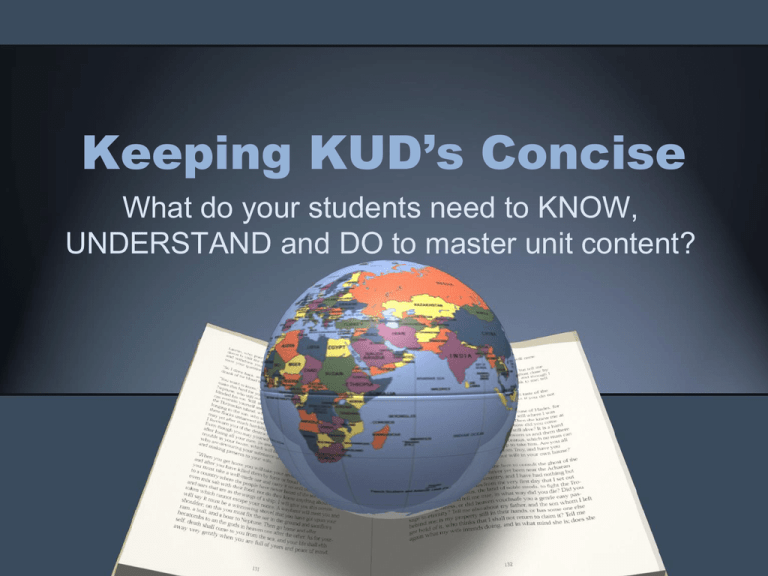
Keeping KUD’s Concise What do your students need to KNOW, UNDERSTAND and DO to master unit content? Today’s Agenda I. Welcome/Self Assessment II. Standards: CCSS vs. Delaware Prioritized Where are they located? What are Concept Organizers? III. KUD Rubric How will this be used? What resources are available? IV. Steps taken to create KUD V. View sample KUD’s VI. Scaffolds VII. Reflection Logs VIII. Questions???? START WITH THE STANDARDS • All units need to address the Common Core State Standards. CCSS • All units need to integrate reading, writing, researching, speaking and listening components. • ELA and Math will only use CCSS. • Other content areas will also use DE Prioritized Standards. DE Standards DE CCSS Website Each tool kit is set up in the same fashion: *General Information *Assessment *Curriculum Tools *Professional Development *Resources DE Prioritized Standards Our units need to focus on the essential standards In each content area. Concept Organizers • These are tools created to assist you in developing your own KUD’s –IMPORTANT: THESE ARE NOT KUD’S. • There are concept organizers for each content area. • These are found on the DE CCSS Website • ELA • MATH (Learning Progressions) • SCIENCE • SOC. STS/HISTORY • TECHNICAL SUBJECTS Creating a KUD • Step One: Identify the “BIG IDEA” or Key Learning you want your students to know, Know Understand understand, and do. Do ( (Big idea, large concept, declarative statement of an enduring understanding) An author’s language, stylistic choices, and devices lead to the primary function of the story. Creating a KUD • Step Two: Cluster the essential standards necessary to acquire the “BIG IDEA” or Key Learning • • • • • • • • • • • • • • • Common Core State Standards Addressed: CC.9-10.R.L.1 Key Ideas and Details: Cite strong and thorough textual evidence to support analysis of what the text says explicitly as well as inferences drawn from the text. CC.9-10.R.I.1 Key Ideas and Details: Cite strong and thorough textual evidence to support analysis of what the text says explicitly as well as inferences drawn from the text. CC9-10RL2: Key Ideas and Details: Determine a theme or central idea of a text and analyze in detail its development over the course of the text, including how it emerges and is shaped and refined by specific details; provide an objective summary of the text. CC.9-10.R.I.2 Key Ideas and Details: Determine a central idea of a text and analyze its development over the course of the text, including how it emerges and is shaped and refined by specific details; provide an objective summary of the text. CC9-10RL3: Key Ideas and Details: Analyze how complex characters (e.g., those with multiple or conflicting motivations) develop over the course of a text, interact with other characters, and advance the plot or develop the theme. CC.9-10.R.I.3 Key Ideas and Details: Analyze how the author unfolds an analysis or series of ideas or events, including the order in which the points are made, how they are introduced and developed, and the connections that are drawn between them. CC.9-10.R.L.4 Craft and Structure: Determine the meaning of words and phrases as they are used in the text, including figurative and connotative meanings; analyze the cumulative impact of specific word choices on meaning and tone (e.g., how the language evokes a sense of time and place; how it sets a formal or informal tone). CC.9-10 W.2: Write informative or explanatory texts to examine and convey complex ideas, concepts, and information clearly and accurately through the effective selection, organization, and analysis of content. CC9-10W4: Produce clear and coherent writing in which the development, organization, and style are appropriate to task, purpose, and audience. (use writing rubrics to assess outcome) CC9-10W6: Use technology, including the Internet, to produce, publish, and update individual or shared writing products, taking advantage of technology's capacity to link to other information and to display information flexibly and dynamically. CC9-10SL1: Initiate and participate effectively in a range of collaborative discussions (one-on-one, in groups, and teacher-led) with diverse partners on grades 9-10 topics, texts, and issues, building on others' ideas and expressing their own clearly and persuasively. CC9-10SL5: Make strategic use of digital media (e.g., textual, graphical, audio, visual, and interactive elements) in presentations to enhance understanding of findings, reasoning, and evidence and to add interest. CC9-10L1a Use parallel structure.* CC9-10L4a Use context (e.g., the overall meaning of a sentence, paragraph, or text; a word's position or function in a sentence) as a clue to the meaning of a word or phrase. Creating a KUD Step Three: Break down the standards into knows and dos. Know Understand concepts, facts, formulas, key vocabulary) Students will Know: Literary Texts Informational Texts Textual Evidence Literary Terms/Devices Character Types & development Story elements Steps for conducting an analysis Components of an Essay Steps for compare & contrast Parallelism Various uses of technology Steps in Collaboration (Big idea, large concept, declarative statement of an enduring understanding) (Note: An author’s language, stylistic choices, and devices lead to the primary function of the story. Do (Skills, competencies) Students will: Cite strong and thorough textual evidence to support analysis of what the text says explicitly as well as inferences drawn from the text. (CC9-10RL1) (CC9-10RI1) Determine the meaning of words and phrases as they are used in the text, including figurative and connotative meanings/Use context as a clue to the meanings of words(CC9-10RL4) (CC9-10L4a) Examine literary devices used to convey the theme of a story(CC910RL2) Evaluate the details that support the theme (CC9-10RL2) Explain what specific lines of dialog reveal about a character (CC910RL3) Analyze complex characters(CC9-10RL3) Analyze the plot sequence of a story(CC9-10RL3) Explain how authors’ choices about presentation of information controls readers’ understandings of the central idea (CC9-10RI3) Produce clear and coherent writing in which the development, organization, and style are appropriate to task, purpose, and audience. (CC.9-10 W.4) Write an effective compare/contrast essay (CC.9-10 W.2) Use parallelism (CC9-10L1a) Use technology appropriately (CC.9-10 W.6) Participate in collaborative discussions (CC9-10SL1) Use digital media in presentations (CC.9-10 W.6)( CC9-10SL5) Creating the KUD • Step Four: Make sure that your knows line up with the dos. • EXAMPLE: • KNOWS: Literary Texts • Informational Texts • Textual Evidence • All match with • DO: Cite strong and thorough textual evidence to support analysis of what the text says explicitly as well as inferences drawn from the text. • The Power of the Written Word Creating a KUD • Step Five: Use rubric to test KUD’s functionality. • Tips: • Knows are facts, figures, vocabulary • Dos begin with a verb and are skills, competencies, real world outcomes • Understand –just one. LFS Unit Tips: KUD Rubric KNOW UNDERSTAND Exemplary Solid Developing Knows are accurately placed & match do Knows are accurately placed. Knows are inconsistently placed. Address facts, details, vocabulary, etc. Address essential information Does not address essential information Understand includes big idea of the unit Understand includes big idea of the unit Only one Only one Understand does not address the big idea of the unit Could answer the UEQ DO General More than one listed Clearly represent the following: skills, real world outcomes, standards Begins with an action verb Are real world outcomes Some dos are activities Begins with an action verb May not begin with action verb Elements reinforce and support each other Organized the knows and dos appropriately Elements are incorrectly placed Standards are clearly embedded in all elements of KUD Link to standards present Does not link to appropriately standards Standards Concept Organizers Additional Scaffolding Resources: Pearson ETeach • http://www.phschool.com/eteach/language_arts/2002_12/essay.html Literacy without Limits http://www.literacywithoutlimits.org/ Scaffolding for Struggling Readers • http://faculty.scf.edu/sharric/softchalk/Lesson12b/EPIModule12/EPIModule1210.html
